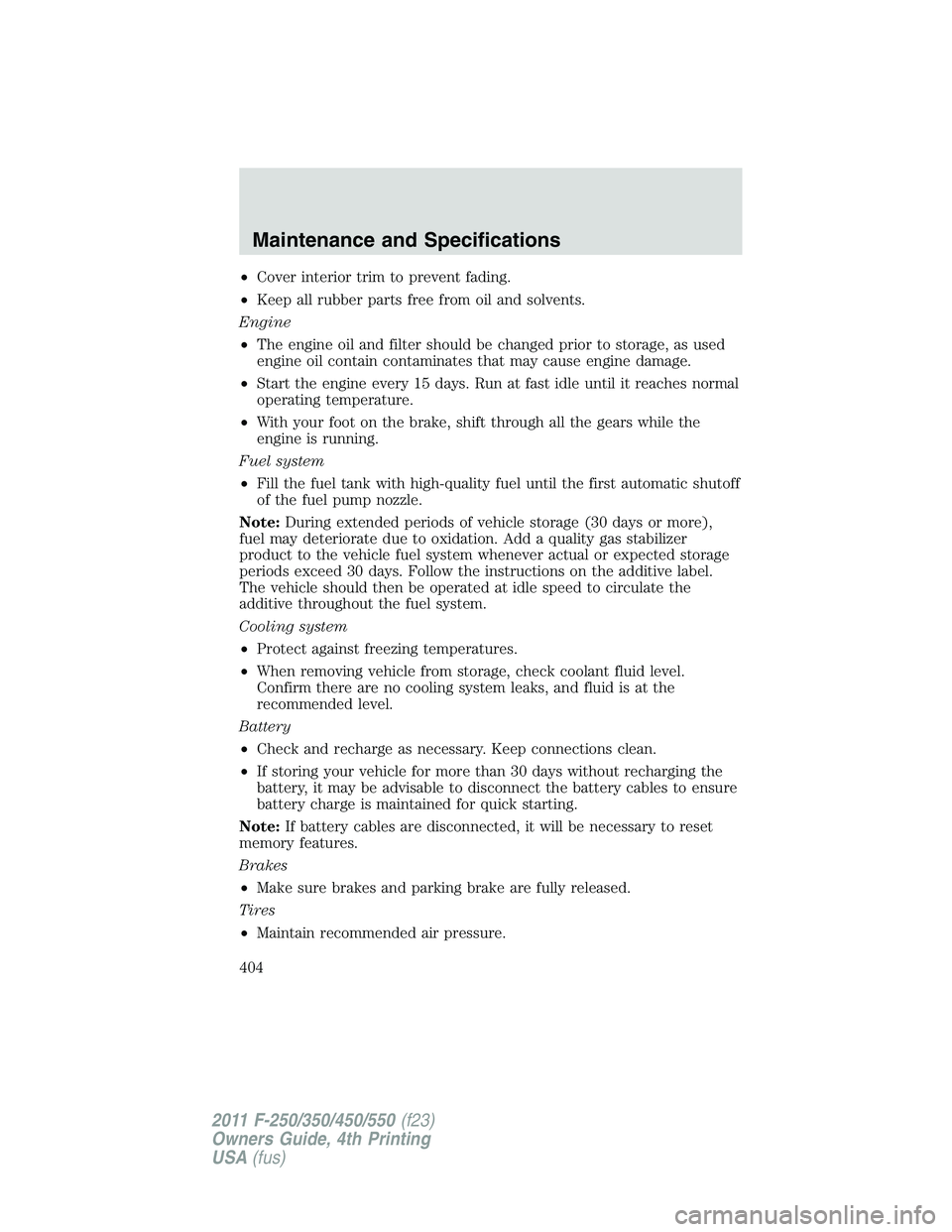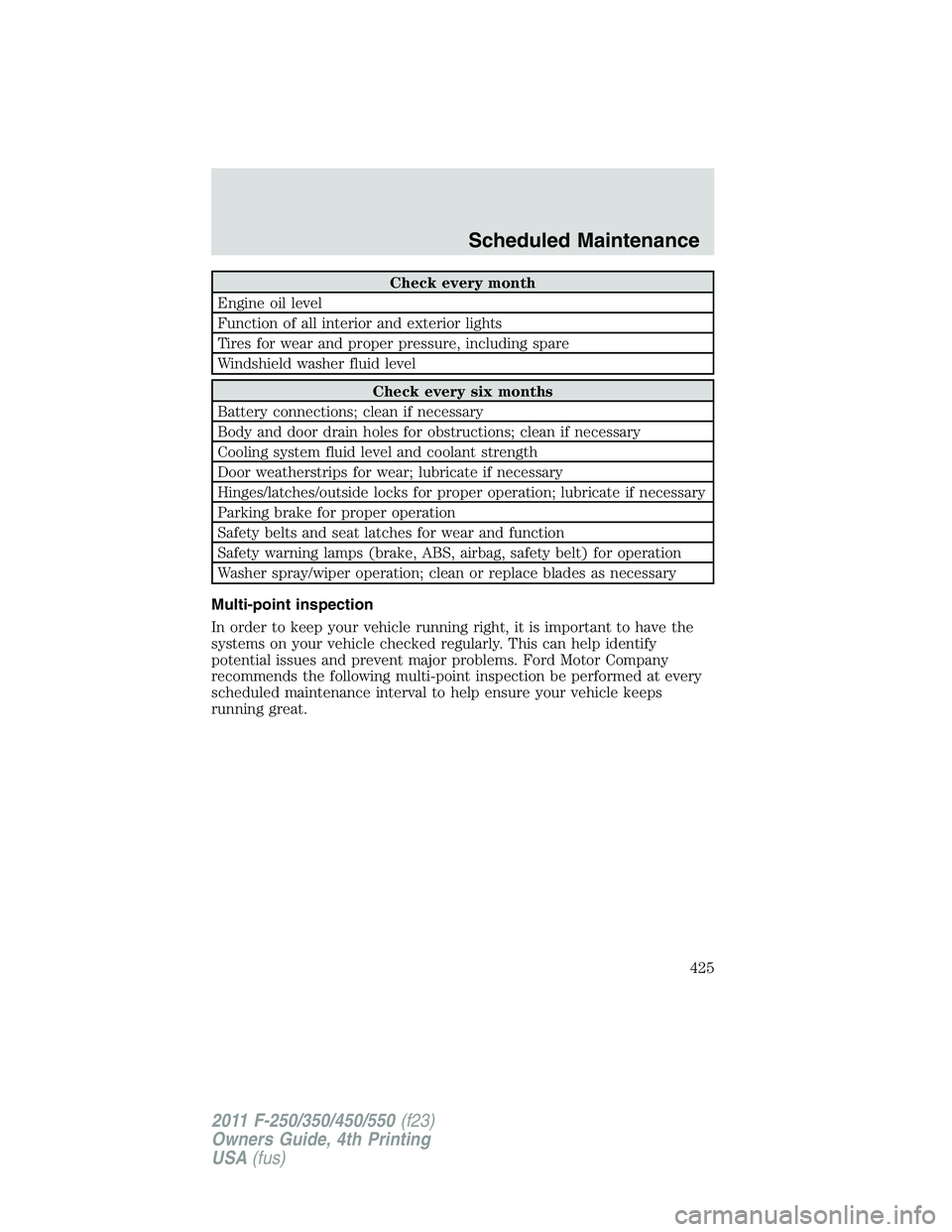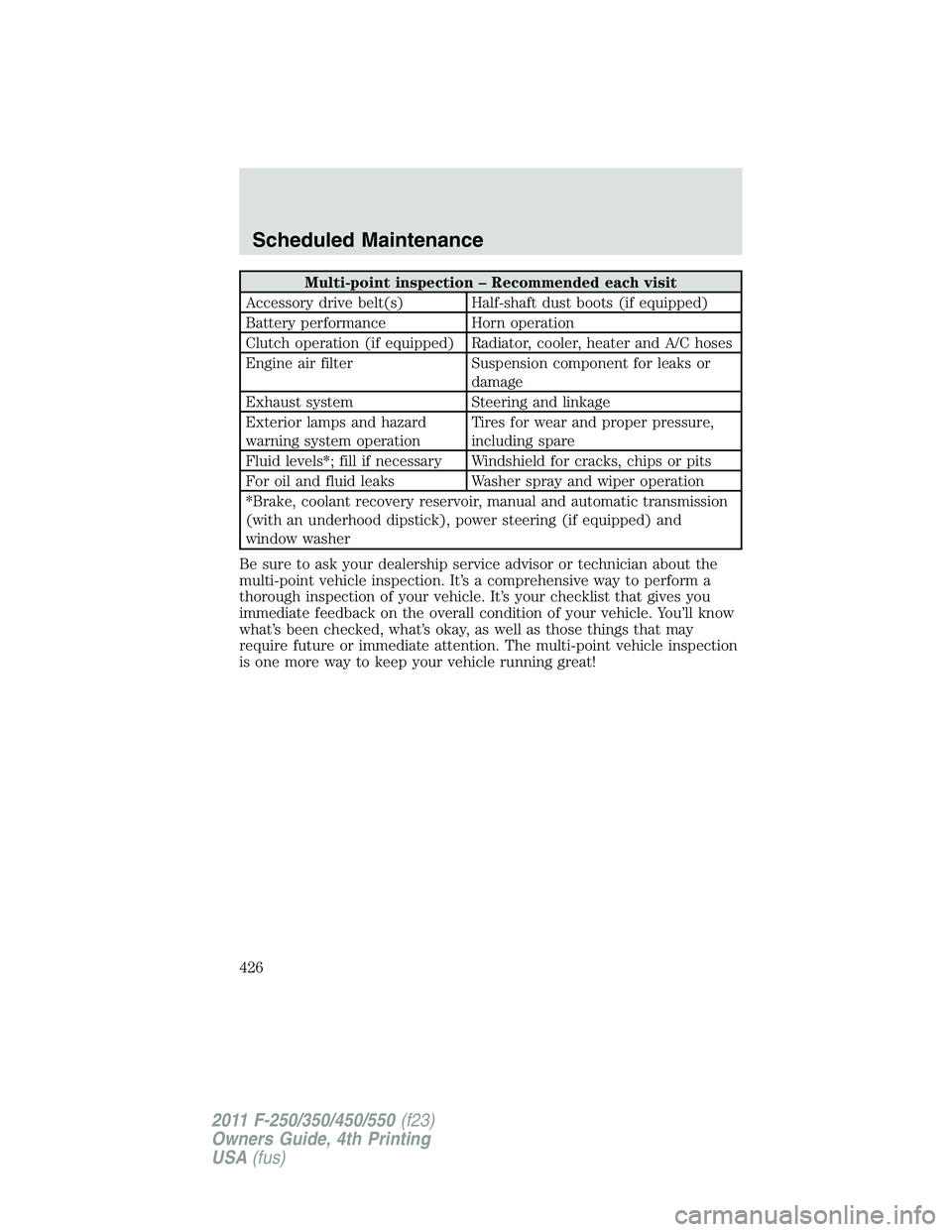Page 404 of 449

• Cover interior trim to prevent fading.
• Keep all rubber parts free from oil and solvents.
Engine
• The engine oil and filter should be changed prior to storage, as used
engine oil contain contaminates that may cause engine damage.
• Start the engine every 15 days. Run at fast idle until it reaches normal
operating temperature.
• With your foot on the brake, shift through all the gears while the
engine is running.
Fuel system
• Fill the fuel tank with high-quality fuel until the first automatic shutoff
of the fuel pump nozzle.
Note: During extended periods of vehicle storage (30 days or more),
fuel may deteriorate due to oxidation. Add a quality gas stabilizer
product to the vehicle fuel system whenever actual or expected storage
periods exceed 30 days. Follow the instructions on the additive label.
The vehicle should then be operated at idle speed to circulate the
additive throughout the fuel system.
Cooling system
• Protect against freezing temperatures.
• When removing vehicle from storage, check coolant fluid level.
Confirm there are no cooling system leaks, and fluid is at the
recommended level.
Battery
• Check and recharge as necessary. Keep connections clean.
• If storing your vehicle for more than 30 days without recharging the
battery, it may be advisable to disconnect the battery cables to ensure
battery charge is maintained for quick starting.
Note: If battery cables are disconnected, it will be necessary to reset
memory features.
Brakes
• Make sure brakes and parking brake are fully released.
Tires
• Maintain recommended air pressure.Maintenance and Specifications
404
2011 F-250/350/450/550 (f23)
Owners Guide, 4th Printing
USA (fus)
Page 405 of 449

Miscellaneous
• Make sure all linkages, cables, levers and pins under vehicle are
covered with grease to prevent rust.
• Move vehicles at least 25 feet (8 m) every 15 days to lubricate
working parts and prevent corrosion.
Removing vehicle from storage
When your vehicle is ready to come out of storage, do the following:
• Wash your vehicle to remove any dirt or grease film build-up on
window surfaces.
• Check windshield wipers for any deterioration.
• Check under the hood for any foreign material that may have collected
during storage (mice/squirrel nests).
• Check the exhaust for any foreign material that may have collected
during storage.
• Check tire pressures and set tire inflation per the Tire Label.
• Check brake pedal operation. Drive the vehicle 15 ft (4.5 meters) back
and forth to remove rust build-up.
• Check fluid levels (including coolant, oil and gas) to make sure there
are no leaks, and fluids are at recommended levels.
• If the battery was removed, clean the battery cable ends and inspect.
If you have any concerns or issues, contact your authorized dealer. Maintenance and Specifications
405
2011 F-250/350/450/550 (f23)
Owners Guide, 4th Printing
USA (fus)
Page 425 of 449

Check every month
Engine oil level
Function of all interior and exterior lights
Tires for wear and proper pressure, including spare
Windshield washer fluid level
Check every six months
Battery connections; clean if necessary
Body and door drain holes for obstructions; clean if necessary
Cooling system fluid level and coolant strength
Door weatherstrips for wear; lubricate if necessary
Hinges/latches/outside locks for proper operation; lubricate if necessary
Parking brake for proper operation
Safety belts and seat latches for wear and function
Safety warning lamps (brake, ABS, airbag, safety belt) for operation
Washer spray/wiper operation; clean or replace blades as necessary
Multi-point inspection
In order to keep your vehicle running right, it is important to have the
systems on your vehicle checked regularly. This can help identify
potential issues and prevent major problems. Ford Motor Company
recommends the following multi-point inspection be performed at every
scheduled maintenance interval to help ensure your vehicle keeps
running great. Scheduled Maintenance
425
2011 F-250/350/450/550 (f23)
Owners Guide, 4th Printing
USA (fus)
Page 426 of 449

Multi-point inspection – Recommended each visit
Accessory drive belt(s) Half-shaft dust boots (if equipped)
Battery performance Horn operation
Clutch operation (if equipped) Radiator, cooler, heater and A/C hoses
Engine air filter Suspension component for leaks or
damage
Exhaust system Steering and linkage
Exterior lamps and hazard
warning system operation Tires for wear and proper pressure,
including spare
Fluid levels*; fill if necessary Windshield for cracks, chips or pits
For oil and fluid leaks Washer spray and wiper operation
*Brake, coolant recovery reservoir, manual and automatic transmission
(with an underhood dipstick), power steering (if equipped) and
window washer
Be sure to ask your dealership service advisor or technician about the
multi-point vehicle inspection. It’s a comprehensive way to perform a
thorough inspection of your vehicle. It’s your checklist that gives you
immediate feedback on the overall condition of your vehicle. You’ll know
what’s been checked, what’s okay, as well as those things that may
require future or immediate attention. The multi-point vehicle inspection
is one more way to keep your vehicle running great!Scheduled Maintenance
426
2011 F-250/350/450/550 (f23)
Owners Guide, 4th Printing
USA (fus)
Page 448 of 449

SecuriLock passive anti-theft
system ................................147–148
Servicing your vehicle ..............366
Setting the clock ...................60, 62
Snowplowing .................7, 311–312
SOS Post Crash Alert ...............187
Spark plugs,
specifications .....................406, 411
Special notice ................................8
ambulance conversions ..............8
diesel-powered vehicles .............7
four-wheel drive vehicles .......313
utility-type vehicles ....................7
Speed control ............................109
Starting a flex fuel vehicle .......265
Starting your vehicle ........262–265
jump starting ..........................343
Steering wheel
controls ....................................111
tilting .........................................98
SYNC � ..........................................76
T
Tailgate ......................................121
Tilt steering wheel ......................98
Tire Pressure Monitoring
System (TPMS)
Tires, Wheels and Loading ....234
Tires ...........................216–218, 326
alignment ................................226
care ..........................................222
changing ..................326, 329, 332
checking the pressure ............221
inflating ...................................219
label .........................................233
replacing ..................................224 rotating ....................................227
safety practices .......................225
sidewall information ...............228
snow tires and chains ............241
spare tire .................................327
terminology .............................218
tire grades ...............................217
treadwear ........................217, 223
Towing .......................................249
recreational towing .................261
Trailer Brake
Controller-Integrated ..............254
trailer towing ..........................249
wrecker ....................................347
Traction control ........................270
Trailer Brake
Controller-Integrated ................254
Trailer sway control ..................277
Transfer case
fluid checking .........................400
Transmission .............................284
brake-shift interlock (BSI) ....282
fluid, checking and adding
(automatic) .............................396
fluid, refill capacities ..............407
Turn signal ..................................90
U
Universal garage door opener ..114
Upfitter controls .......................112
USB port ......................................70
V
Vehicle Identification Number
(VIN) ..........................................413
Vehicle loading ..........................242
Ventilating your vehicle ...........266Index
448
2011 F-250/350/450/550 (f23)
Owners Guide, 4th Printing
USA (fus)